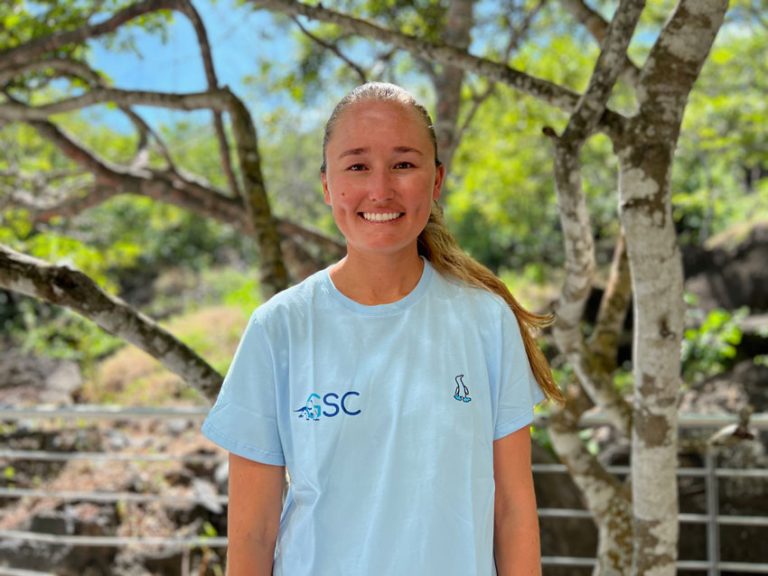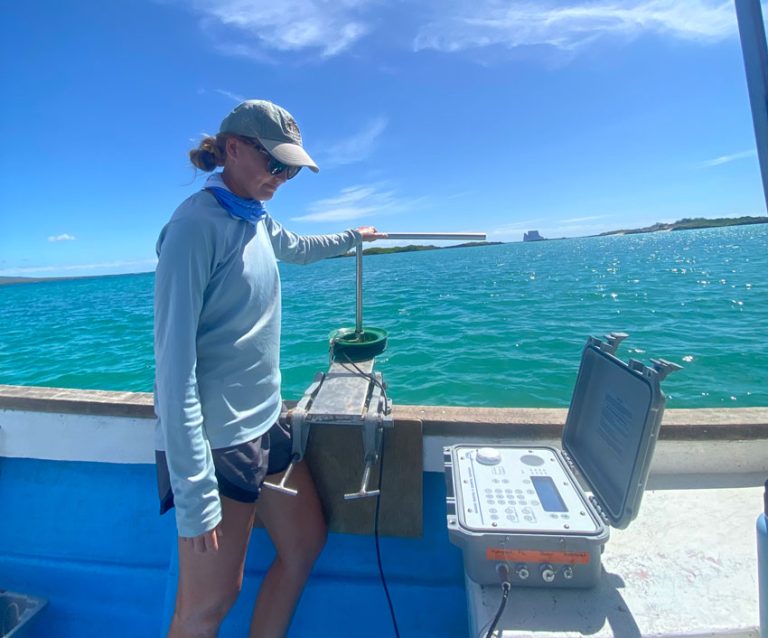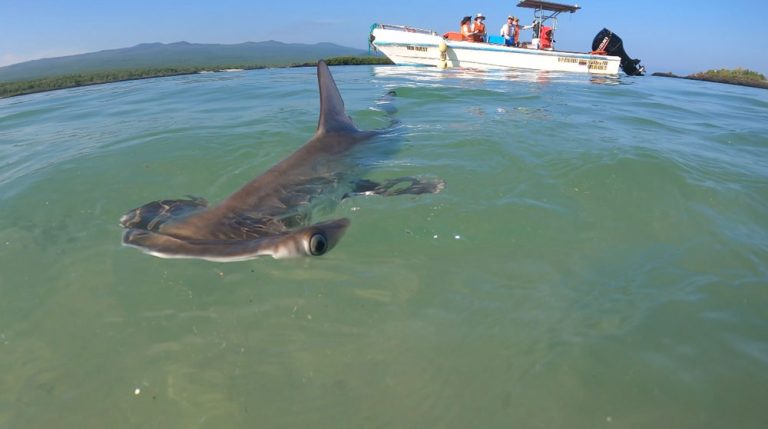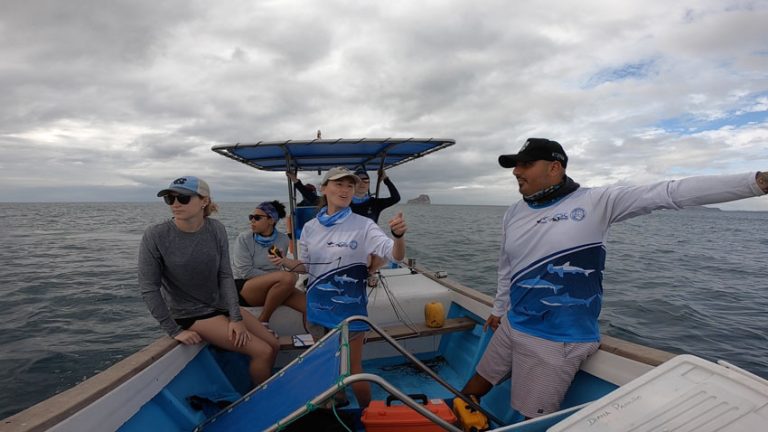
It’s 5 p.m., the sun is starting to set and many people are heading home for the day. But Savannah Ryburn has just tagged one of the Galapagos’ elusive juvenile scalloped hammerhead sharks and started the clock. For the next 24 hours, she will stay on her boat monitoring a hydrophone – an instrument that emits steady beeps as it picks up signals from the acoustic tag attached to the shark’s fin – steering the boat to stay close to the shark and recording the shark’s movements. Aside from a short nap around 5 a.m., which is interrupted by a pelican roosting on her head, she will not sleep.
For many people, spending 24 straight hours on a boat with nothing but the beeping of a hydrophone and a sleepy team to accompany them sounds like a nightmare. But, for Ryburn, it’s just part of the job.
A UNC Ph.D. student in the Environment, Ecology and Energy Program in the College of Arts and Sciences, Ryburn has dedicated the last five years to researching the diet of juvenile blacktip and scalloped hammerhead sharks in the Galapagos Islands using a cutting-edge technique called metabarcoding. She supplements her study of their diets with information about their movements, such as the data she collected during her 24-hour tracking project.

This tracking project, during which she did not lose the shark’s trail once, is not the first time Savannah has proven her dedication to her research – or how important her work is. Juvenile blacktip and scalloped hammerhead sharks spend this part of their life cycle in bays around the Galapagos, and while the juvenile blacktip populates bays all over the archipelago, there were only two known bays occupied by juvenile scalloped hammerheads when Savannah began her research five years ago.
However, during the summer of 2022 Ryburn, along with members of the Galapagos National Park, discovered a new juvenile scalloped hammerhead nursery bay on Isabela Island. Ryburn and the team from the national park spent two weeks exploring different bays around the archipelago but only found juvenile blacktips. It wasn’t until the final bay on their final day of the trip that the team struck gold. They dropped lines and immediately caught five scalloped hammerheads, a discovery vital not only for Ryburn’s research but also the collective knowledge about the sharks’ habitats in the Galapagos.
For Ryburn, the effort required in her work is a worthwhile sacrifice for the ability to help these animals, particularly the juvenile scalloped hammerheads, which are a critically endangered species. Their endangered status necessitates Ryburn’s metabarcoding technique, a safe alternative to the standard method in diet analysis. The standard method of lethal gut analysis, like its name suggests, involves killing and dissecting a subject to visually determine its stomach’s contents.
Lethal gut analysis is not only inhumane but is also not always accurate or precise, given that it relies on visual analysis. Metabarcoding fecal matter, on the other hand, is a non-lethal technique that allows researchers to determine an animal’s diet through DNA sequencing, often identifying prey down to the species level.

“Especially when you’re working with a critically endangered species like the scalloped hammerhead, I wouldn’t be able to do any sort of diet study on them if it weren’t for the new method,” Ryburn noted.
When testing her animals, Ryburn is able to complete a workup of each shark in about two minutes, during which she takes basic measurements and swabs the shark’s cloaca for a sample and then releases them safely back into the water. After collecting the swab, she completes the metabarcoding part of the analysis herself in the Microbiology & Molecular Biology Lab at the Galapagos Science Center and the Bruno lab at UNC up until the actual sequencing, which the UNC sequencing core is able to complete.
Using this method, Ryburn has not had a single scalloped hammerhead shark die during their interactions and has been able to determine everything that her sharks – both the scalloped hammerhead and blacktip – have eaten down to the genus level and almost everything down to the species level.

The end goal for her tireless research? Ryburn looks forward to her data informing practical conservation measures of these shark species, especially the critically endangered scalloped hammerhead. In particular, she hopes that the Galapagos National Park will be able to use her findings to create reasonable fishing restrictions to protect the species that these sharks are eating. Fishing restrictions are difficult to uphold across the islands, and fishing is important to the livelihoods of many locals in the Galapagos community. But by targeting just the species of fish that Ryburn’s two shark species eat, a possibility thanks to her use of metabarcoding, the Galapagos National Park can create rules designed to limit fishing of those specific species and allow both the fisherfolk and sharks to thrive.
“It’s extremely rewarding,” Ryburn said of her research, “because, first off, I get to work with a critically endangered species that most of the world probably never ever gets to see in their entire life … And then I have the opportunity to help conserve them, hopefully provide benefits to their survival and hopefully help them not become extinct.”
UNC-Chapel Hill celebrates University Research Week Oct. 23-27 with the theme, “A Climate of Change at Carolina.” Stay tuned to the College website all week for stories like Ryburn’s as we share news about Carolina student and faculty researchers.
By Andy Little ‘24, Center for Galapagos Studies
